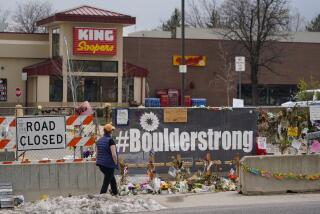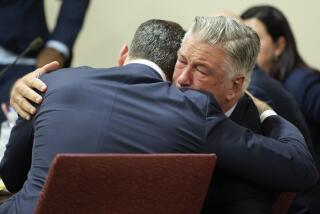‘Twilight Zone’ Trial to Begin This Week
- Share via
More than four years after the horrendous helicopter crash that took the lives of actor Vic Morrow and two child actors on the set of “Twilight Zone: The Movie,” the curtain is finally about to rise on “Twilight Zone: The Trial.”
On Wednesday, Deputy Dist. Atty. Lea Purwin D’Agostino is scheduled to make her opening statement and later call her first witnesses against director John Landis and four associates, each of whom are charged with involuntary manslaughter.
Since the time of the tragedy on the film set near Saugus, a swirl of publicity has surrounded the case, with international media coverage ranging from gory specifics of the victims’ injuries to such light fare as details of where Landis dined the afternoon before jury selection began.
But now, after a monthlong jury selection process that concluded last week, 12 Los Angeles County residents will finally be asked by Los Angeles Superior Court Judge Roger Boren to put aside any preconceptions and, once and for all, decide the key issue:
Should the defendants, none of whom has criminal records or had deliberately sought to injure the actors, be judged criminally responsible for the fatalities?
More than 100 witnesses--ranging from on-the-scene film crew workers to Hollywood directors who would explain the proper means of filming special effects sequences--are expected to testify for the prosecution.
“The people’s burden of proof is to establish gross negligence,” D’Agostino said. “And as the witnesses come forward to testify as to what occurred on that set, these facts will become quite manifest.”
Landis, associate producer George Folsey Jr., unit production manager Dan Allingham, helicopter pilot Dorcey A. Wingo and special-effects coordinator Paul Stewart are accused of homicide in the deaths of Morrow, 53, and Vietnamese immigrant children Renee Chen, 6, and Myca Dinh Lee, 7.
The actors were killed July 23, 1982, when, during the shooting of a Vietnam War battle sequence, a helicopter spun out of control and crashed down upon them, decapitating Morrow and Lee and crushing Chen.
Among the issues D’Agostino is expected to stress during the anticipated four-month trial are the low level at which the helicopter hovered near the actors--apparently about 20 feet above ground--the alleged conspiracy of Landis, Allingham and Folsey to illegally hire the children to work at night without state permits, and the massive special effects explosions set off near the helicopter.
D’Agostino has told the court that she plans to show the jury film footage of the fatal scene. And she also intends to call witnesses from previous “Twilight Zone” hearings who have testified to statements attributed to Folsey and Landis: In Folsey’s case, a comment that he and others would probably be thrown in jail for hiring the children without state permits; and with Landis, an ultimately prophetic retort to complaints that a dress rehearsal of the ill-fated scene was dangerous. Landis, the prosecution contends, “simply said, “That is just a warm up for what’s coming.”
Although D’Agostino is reluctant to discuss in greater detail her trial strategy outside court, she has indicated that she will stick to the tack employed by Deputy Dist. Atty. Gary P. Kesselman, who handled the case during the pretrial stages.
“The underlying theme of this case is that you don’t fly helicopters into or near fireballs or special effects explosions,” Kesselman said at a 1984 hearing before Superior Court Judge Gordon Ringer. “Something might happen.”
After that session, Ringer agreed that the case should go to trial.
“This isn’t nickelodeon time anymore,” the judge explained at the 1984 hearing. “But I should have thought that after 75 years, somebody might have thought it inappropriate to put Lillian Gish on an ice floe and send her into the middle of Niagara Falls to make a movie. . . .
“Whether a jury will determine that one or more of the defendants was simply civilly negligent or whether a jury will determine that they are all criminally negligent is not for me,” Ringer continued. “But this is a case to be tried.”
At that pretrial stage, probable cause of guilt was the standard for sending the case to trial. Now, the jury must find the film makers guilty beyond a reasonable doubt in order to convict them.
“The basic defense,” said Landis’ counsel, James F. Neal, “will be that there was absolutely no criminal negligence involved in this. It just simply was a tragic accident. Accidents do happen.”
More specifically, defense attorneys are expected to assert that their clients exercised adequate care and did not realize the risks involved in filming the fatal sequence.
The defense will also highlight evidence concerning the specific scientific reasons for the crash, and will question the prosecution’s decision to single out the five defendants from among the more than 100 people on the film set.
Folsey’s attorney, for example, maintains that even if the helicopter was downed in part by exploding special effects debris, it would have crashed anyway due to the heat from a fireball that caused the metal skin of its rear rotor blade to peel away. In recent court papers, Folsey’s lawyer, Harland Braun, argued that the defendants should not be held liable for the “heat delamination” problem because it was unforeseeable since “there has never been a (previously) recorded incident in history of a helicopter crashing” for that reason.
Blame for Tragedy
Stewart’s lawyer, Arnold L. Klein, has indicated that he believes that any blame for the tragedy could actually rest with his client’s assistants, who helped set up the mortars and other devices for the fatal scene.
“If an employee did not perform properly,” Klein explained last week, “. . . then my client (should) walk.”
The employees, who have been granted immunity by the prosecution to testify, have sworn in previous legal hearings that they were following Stewart’s instructions. But Klein, in questioning prospective jurors, hinted that there could be dramatic courtroom confessions by witnesses during the trial.
At this point, the defense attorneys--who theoretically could face conflicting interests due to their clients’ varying levels of potential culpability--have a smooth working relationship. In Klein’s words, they are “a loose confederation” whose main focus is combating the prosecution.
Vocal Warfare
Indeed, the colorful D’Agostino and defense attorneys are pitted in a running battle of vocal warfare.
Neal, for example, has reacted to certain courtroom comments of D’Agostino as “absurd and outrageous,” adding that “nothing surprises me about statements she makes.”
D’Agostino, meanwhile, has been known to mimic Neal’s thick Nashville drawl outside of court.
D’Agostino, 44, referred to by courtroom foes as “The Dragon Lady,” is a hard-nosed prosecutor who dresses as if she stepped out of the pages of a fashion magazine. Before joining the district attorney’s office nine years ago, she worked as an office manager for a theatrical agency, as the manager of a fashionable discotheque, and as an administrative assistant to David O. Selznick, the producer of “Gone With the Wind.”
In keeping with her entertainment industry background, D’Agostino employs a theatrical courtroom style as she tenaciously argues legal points against the defendants’ team of seven male attorneys. Neal, 56, a one-time Watergate special prosecutor, is generally recognized as one of the nation’s foremost defense lawyers.
Client List
Before taking Landis as a client late last year, the Tennessee-based Neal had successfully represented such clients as Louisiana Gov. Edwin W. Edwards on racketeering and fraud charges, Elvis Presley’s doctor on drug charges and Ford Motor Co. on reckless homicide charges in the deaths of three women whose Pinto exploded when hit from behind. Neal is assisted by James Sanders, his Nashville law partner.
The other defense attorneys, all from Los Angeles, are Leonard Levine, representing Allingham, Eugene L. Trope and William B. Anderson defending Wingo, and Klein and Braun.
The feisty Braun, who successfully represented Congresswoman Bobbi Fiedler (R-Northridge) after her grand jury indictment earlier this year, served as Landis’ attorney until Neal was hired. Known for his combative and frequently audacious style--he recently called Chief Deputy Dist. Atty. Gilbert I. Garcetti a “total ignoramus” in written legal motions filed with Judge Boren--Braun provides an intriguing counterpoint to Neal’s courtly country manner.
Then there is the bearded, bespectacled Landis, who, gazing intently at the prospective jurors, exudes an almost professorial air.
Appears Tender, Loving
Landis is accompanied to court each day by his tall, long-tressed wife, Deborah, with whom, during breaks in the proceedings, he holds hands and kisses to the degree that D’Agostino pointed out to prospective jurors that they should not feel favorably inclined to a defendant just because he appears tender and loving in the courtroom.
D’Agostino also asked prospective panelists whether their neutrality would be impaired if Hollywood stars show up in court to display their support for Landis, whose box-office hits include “Trading Places” and “Animal House.” Actors Don Ameche and Ralph Bellamy, who co-starred in “Trading Places,” did just that at the director’s 1984 arraignment.
A repeat occurrence could validate Klein’s recent forecast: “If we could sell tickets, we’d make more money on this trial than the movie made.”
The final key figure is Boren, a low-key, no-nonsense judge who, before his appointment to the bench, served as a co-prosecutor in the Hillside Strangler case while working as a deputy attorney general.
Delayed by Appeals
For the past four years, the Twilight Zone case has slowly wended its way through the legal system, delayed by appeals that reached the state Supreme Court after closed-door grand jury sessions and a preliminary hearing that spanned four months.
As it now stands, Landis, Stewart and Wingo each face three counts of involuntary manslaughter stemming from alleged criminal negligence in the deaths. Landis, Folsey and Allingham, meanwhile, are also charged with two counts of involuntary manslaughter for allegedly endangering the lives of the illegally hired children.
Landis, Folsey and Allingham have long been willing to admit their guilt in illegally hiring the children. However, D’Agostino asserts that all five would have had to plead guilty to each of the manslaughter counts to forgo trial. What’s more, D’Agostino has asserted in court--to the defense’s utter consternation--that had she filed the case herself, she would have actually charged Landis with second-degree murder.
If convicted, Landis would apparently become the first Hollywood director to be held criminally liable for his actions in shooting a film. Involuntary manslaughter counts carry a four-year maximum state prison term.
Profound Effect
Although the prosecution and defense agree on few issues, both sides do acknowledge that the People v. John Landis, et al. is likely to have a profound effect on the world of entertainment.
“It could speak to the roles and responsibilities of various people involved in the movie industry,” Neal said. “There are real policy questions involved in the attempt to apply criminal laws and sanctions to non-intentional conduct.”
Indeed, D’Agostino asserted, the case has already had a positive impact on film safety.
“People are more cautious as a result of what happened on the set,” she said. “I would have to feel the thought of facing prosecution would have a role in that.”
A conviction of Landis and company, D’Agostino added, “would send a message that there is no scene, no special effect, no motion picture in history worth a human life.”
More to Read
Only good movies
Get the Indie Focus newsletter, Mark Olsen's weekly guide to the world of cinema.
You may occasionally receive promotional content from the Los Angeles Times.










